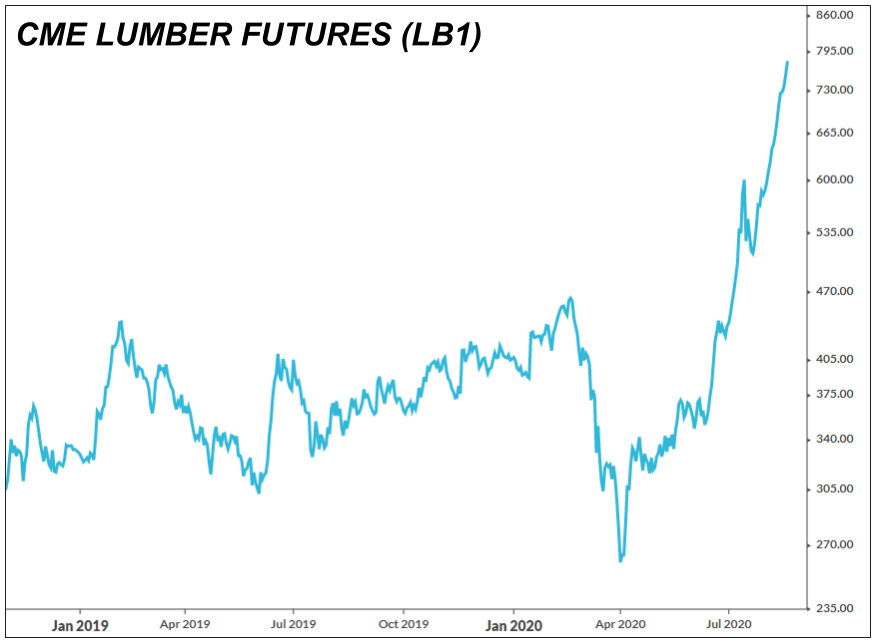Why is the U.S. Housing Market So Strong?
The U.S. housing market is bizarrely strong right now. But why?
Before attempting to answer, we’ll look at some data.
On Aug. 17, the U.S. National Association of Home Builders (NAHB) reported home buyer foot-traffic at all-time highs.
Based on the NAHB/Wells Fargo Housing Market Index, or HMI for short, homebuilder confidence levels are also at all-time highs, matching a December 1998 peak that represents the highest point in the 35-year data series.
Then, too, we know houses are being built at a frantic pace, because lumber prices have gone through the roof (no pun intended). You can see the wild action via the below chart of CME lumber futures, which looks like a rocket ship taking off.

Below, via the St. Louis Federal Reserve, we can also see the monthly U.S. housing supply is at its lowest point in years. Monthly housing supply is the number of homes for sale divided by homes per month sold.
When housing supply is low, there is less inventory on the market relative to demand, which essentially means more buyers chasing fewer properties.

Adding to the bullish housing outlook, U.S. mortgage rates hit their lowest levels in history this month.
According to the Federal Home Loan Mortgage Corp. (also known as Freddie Mac), the 30-year fixed mortgage rate recently fell to 2.88%, its lowest reading since the data series began in 1971.
So, mortgage rates are historically low, and housing supply is tight. If the goal is to explain the strong housing market, those two factors would seem to be enough.
But there is another puzzling data point to consider.
According to the U.S. Mortgage Bankers Association, quarterly delinquency rates on home loans saw a record-breaking increase during the pandemic, going from below 4% to above 8%.
And so, even in the middle of a new housing boom, an alarming number of Americans are falling behind on their mortgage payments. And the number of delinquencies is sure to rise further heading into fall and winter, now that eviction moratoriums have been lifted with stimulus efforts stalled.
We can find a clue in the sale patterns of urban centers versus suburbs and surrounding rural areas.
To state it plainly, knowledge workers are fleeing the cities — often with remote-work permission from their employers — and snapping up homes in the outer suburbs and beyond.
As a result of this exodus, idyllic areas like Lake Tahoe are seeing a boom for the ages, while suburban housing markets in proximity to big cities, like Connecticut versus New York City, are seeing a resurgence.
The work-from-home phenomenon, and increasingly the school-from-home phenomenon, may also explain a pressing need for new construction.
As more knowledge workers settle into working from home, they are discovering that four bedrooms are the must-have number, not three, to have at least one dedicated room for office work and zoom meetings.
A rediscovery of home life — with lots more time confined at home, thanks to the pandemic — has also spurred a remodeling resurgence, which has been fantastic for companies like Lowe’s (LOW) and Home Depot (HD).
In terms of the real economy, though, the housing market is still a mixed bag.
That is because mortgage delinquencies have spiked these past few months, and will surely spike higher with eviction moratoriums lifted and millions of temporary job losses becoming permanent.
Then, too, the exodus out of cities means that urban apartments are being abandoned. A sharp and permanent drop in average apartment rents is likely to show up in the data soon, along with small-business failures for a great many apartment landlords.
We also don’t know whether strong housing demand is permanently reflective of the landscape moving forward, or just a temporary reflection of the pandemic, with the desire to flee cities a temporary thing and a trend driver that will soon lose steam.
And last but not least, we don’t know what happens when the government checks stop coming — or what happens if they don’t. By that meaning, consumer spending kept right on trucking through the pandemic thanks to emergency funds approved by Congress — but we don’t know if robust spending habits, and by extension a solid housing outlook, will continue on with the emergency payments dried up.
All in all, the hot U.S. housing market is a COVID-19 recovery story, marked by an exodus from the cities and a need for expanded work-from-home spaces that well-off Americans can afford to trade up for.
The lowest mortgage rates ever, a product of central bank support, are also a factor in the boom.
But a cratering of apartment rents, and a collapse of real estate values in urban centers, is likely to be a drain on city and state budgets, at a time when the states already feel broke.
We also don’t know if the bullish housing mood will sustain itself in an absence of stimulus — or during a flood of new stimulus for that matter, which could damage confidence in the currency.
In sum, like so much else in the bizarre year that is 2020, the positive message of the housing boom should be interpreted with caution. The demand is real, but the drivers could be temporary, and even cash-flush knowledge workers could take a hit if post-stimulus consumer spending trails off.